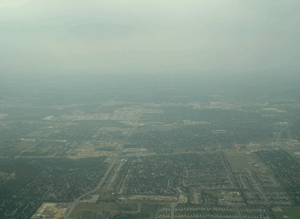
Air pollution has become a serious concern for the San Antonio area, and rising ground-level ozone poses threats to citizens' health and the economy.
According to www.cleanairdrive.com, San Antonio's biggest air pollution concern is ground-level ozone. This problem occurs on the days referred to as Air Quality Health Alert Days. The most popular season to expect these days is during the months of May through September when it is hotter.
The Alamo Area Council of Government's website, aacog.com, reports that ground-level ozone, also known as smog, forms in the atmosphere on warm sunny days. An Air Quality Health Alert is announced to the media and the public as a forewarning. To receive these alerts via e-mail or fax, contact Amber Mayne at (210) 362-5213 or at amayne@aacog.com.
The American Lung Association (ALA) estimates that over 37,692 children and 74,270 adults in Bexar County suffer from breathing difficulties, like asthma, that make them susceptible to poor health from air pollution. Because of the number of bad air days in 2003-2005, ALA gave Bexar County's air quality a grade of F.
San Antonio Express-News environmental writer Anton Caputo reported that the federal government says a community must have a three-year running average of 84 parts per billion (ppb) of ozone or less to remain in compliance.
San Antonio's 2005 eight-hour average ozone level was 86 (ppb) and 2006's was 87 ppb. San Antonio avoided a non-attainment designation thanks to our cool and rainy summer. 2007's ozone level was 74 ppb, which brought the three-year average to 82 ppb.
Caputo writes that had our ozone level exceeded 84 ppb, "the area would have to institute programs aimed at reducing the nitrogen oxide and sulfur dioxide that help form ozone pollution. These programs would make it harder for businesses that emit air pollution to expand or open shop locally. The feds also could require vehicle emissions testing and pull federal highway funds." The Environmental Protection Agency (EPA) is considering lowering the standard from 84 to 70 or 75 parts per billion, which scientists say would decrease the number of deaths caused by breathing bad air.
"One of the biggest problems with San Antonio's air quality are the vehicles," said Taylor Coffee, an Education major.
According to the U.S. Environmental Protection Agency, driving a car is the single most polluting thing that most of us do.
Brad Chandler, Associate Professor of Biology at Palo Alto College, said he believed coal-burning power plants and car exhausts were the main sources of air pollution in San Antonio.
"Texas has a hunger for trucks and SUVS that pollute the air," he said.
W.T. Hill, a Palo Alto Psychology major, said, "My worst complaint is that there are too many soccer moms that commute single passenger to the grocery store in an F-350." Eryn Coldewey, a freshman Kinesiology major, said, "I carpool to school with a friend that lives by me to be more fuel efficient."
Drive Clean Across Texas suggests five ways to help: 1) Maintain your vehicle in top running order; 2) Drive less; 3) Buy a "cleaner" vehicle, like a hybrid or low-emission vehicle; 4) Drive the speed limit; and 5) Limit idling.
To find out what else you can do to help improve our air quality, surf to www.drivecleanacrosstexas.org